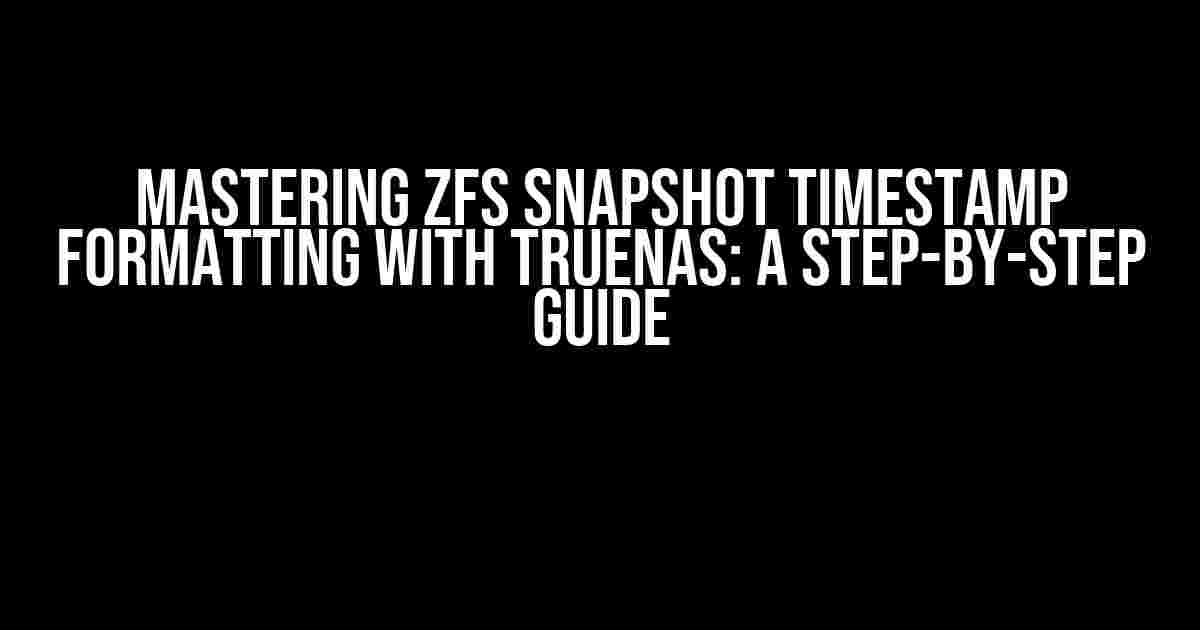As a TrueNAS user, you’re already well-versed in the world of ZFS snapshots, but have you ever wondered how to customize the creation timestamp of your snapshots? Look no further! In this comprehensive guide, we’ll delve into the world of timestamp formatting and walk you through the process of tailoring your snapshot timestamps to your specific needs.
Why Format Snapshot Timestamps?
Before we dive into the how, let’s discuss the why. Formatting snapshot timestamps can be incredibly useful for a variety of reasons:
- Improved organization**: Custom timestamps make it easier to identify and categorize snapshots, allowing you to quickly locate specific snapshots based on their creation time.
- Better naming conventions**: Formatting timestamps enables you to create consistent and meaningful naming conventions, making it simpler to understand the purpose and scope of each snapshot.
- Enhanced automation**: By using custom timestamp formats, you can automate snapshot creation and management tasks, such as creating daily or weekly snapshots, with ease.
Understanding ZFS Snapshot Timestamps
By default, ZFS snapshot timestamps are displayed in the following format:
YYYY-MM-DD-HH-MM-SS
This format is straightforward, but it may not be suitable for everyone’s needs. That’s where TrueNAS comes in, providing an intuitive way to customize snapshot timestamps.
Formatting Snapshot Timestamps with TrueNAS
To format snapshot timestamps with TrueNAS, follow these steps:
- Log in to your TrueNAS web interface and navigate to the Storage section.
- Click on the Snaps tab and select the dataset or zvol you want to work with.
- Click the drei-dots button next to the dataset or zvol and select Snapshot Manager.
- In the Snapshot Manager, click the gear icon next to the Snapshots dropdown menu and select Preferences.
- In the Preferences window, navigate to the Timestamp Format section.
- In the Timestamp Format field, enter your desired timestamp format using the syntax discussed below.
- Click Save to apply the changes.
Timestamp Format Syntax
The timestamp format syntax used in TrueNAS is based on the strftime format specifiers. Here are some common format specifiers you can use:
| Specifier | Description | Example |
|---|---|---|
| %Y | Year (four digits) | 2022 |
| %m | Month (01-12) | 07 |
| %d | Day of the month (01-31) | 25 |
| %H | Hour (00-23) | 14 |
| %M | Minute (00-59) | 30 |
| %S | Second (00-59) | 00 |
Using these format specifiers, you can create custom timestamp formats that suit your specific needs. For example:
%Y-%m-%d-%H-%M-%S
This format would result in a timestamp like:
2022-07-25-14-30-00
Advanced Timestamp Formatting
In addition to the basic format specifiers, TrueNAS also supports advanced timestamp formatting using conditional statements and macro expansions.
Conditional Statements
You can use conditional statements to format timestamps based on specific conditions. For example:
(%H >= 12 ? %p : %I)
This format would display the timestamp in 12-hour format with AM/PM notation if the hour is greater than or equal to 12, and in 24-hour format otherwise.
Macro Expansions
TrueNAS also supports macro expansions, which allow you to insert dynamic values into your timestamp format. For example:
%Y-%m-%d-%H-%M-%S-%%{ hostname }
This format would include the hostname of the system in the timestamp, making it easier to identify snapshots from different systems.
Best Practices for Snapshot Timestamp Formatting
When formatting snapshot timestamps, keep the following best practices in mind:
- Keep it simple**: Avoid using overly complex formats that may be difficult to read or understand.
- Be consistent**: Use a consistent format throughout your TrueNAS environment to ensure easy identification and management of snapshots.
- Use meaningful names**: Include meaningful information in your timestamp format, such as the dataset or zvol name, to provide context and clarity.
Conclusion
Formatting snapshot timestamps with TrueNAS is a powerful feature that can greatly enhance your ZFS snapshot management experience. By following the steps outlined in this guide, you can create custom timestamp formats that meet your specific needs and improve your overall TrueNAS workflow. Remember to keep it simple, be consistent, and use meaningful names to get the most out of this feature.
Happy snapshotting!
Frequently Asked Question
Get your ZFS snapshot timestamp formatted with ease on TrueNAS!
Can I customize the format of the creation timestamp for my ZFS snapshots on TrueNAS?
Yes, you can! TrueNAS allows you to customize the format of the creation timestamp for your ZFS snapshots. You can do this by using the `zfs snapshot` command with the `-t` option, followed by the desired format. For example, `zfs snapshot -t %Y-%m-%d-%H%M%S tank/data@mysnapshot` would create a snapshot with a timestamp in the format `YYYY-MM-DD-HHMMSS`.
What are the available format options for the creation timestamp on TrueNAS?
TrueNAS supports a range of format options for the creation timestamp, including `%Y` for the year, `%m` for the month, `%d` for the day, `%H` for the hour, `%M` for the minute, `%S` for the second, and more. You can combine these format specifiers to create a custom timestamp format that suits your needs. For a full list of supported format options, refer to the TrueNAS documentation or the `zfs` man page.
Can I use a specific timezone for the creation timestamp on my ZFS snapshots?
Yes, you can! By default, TrueNAS uses the system’s local timezone for the creation timestamp. However, you can specify a different timezone by using the `TZ` environment variable. For example, `TZ=America/New_York zfs snapshot -t %Y-%m-%d-%H%M%S tank/data@mysnapshot` would create a snapshot with a timestamp in the America/New_York timezone.
How do I make the customized timestamp format persist across reboots on TrueNAS?
To make the customized timestamp format persist across reboots, you can add the `zfs_snapshot_timestamp_format` parameter to your TrueNAS configuration file. For example, you can add the following line to the `/etc.defaults/zfs` file: `zfs_snapshot_timestamp_format=”%Y-%m-%d-%H%M%S”`. This will set the default timestamp format for all new snapshots created on your TrueNAS system.
Can I apply the customized timestamp format to existing ZFS snapshots on TrueNAS?
Unfortunately, it’s not possible to retroactively apply a customized timestamp format to existing ZFS snapshots on TrueNAS. The timestamp format is determined at the time the snapshot is created, and it cannot be changed later. However, you can create a new snapshot with the desired timestamp format and then delete the old snapshot.


